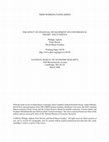Papers by David Mayer-Foulkes
Anthem Press eBooks, Mar 5, 2012
Trade and investment liberalization policies put in place in the 1980's ushered in a new... more Trade and investment liberalization policies put in place in the 1980's ushered in a new era of globalization and currently form the mainstay of global development policy. However, underdevelopment itself originated in the context of globalization in the 19th century. I first summarize the ...

We introduce imperfect creditor protection in a multi-country version of Schumpeterian growth the... more We introduce imperfect creditor protection in a multi-country version of Schumpeterian growth theory with technology transfer. The theory predicts that the growth rate of any country with more than some critical level of financial development will converge to the growth rate of the world technology frontier, and that all other countries will have a strictly lower long-run growth rate. The theory also predicts that in a country that converges to the frontier growth rate, financial development has a positive but eventually vanishing effect on steady-state per-capita GDP relative to the frontier. We present cross-country evidence supporting these two implications. In particular, we find a significant and sizeable effect of an interaction term between initial per-capita GDP (relative to the United States) and a financial intermediation measure in an otherwise standard growth regression, implying that the likelihood of converging to the U.S. growth rate increases with financial development. We also find that, as predicted by the theory, the direct effect of financial intermediation in this regression is not significantly different from zero. These findings are robust to alternative conditioning sets, estimation procedures and measures of financial development.
subject to change without notice. Permission to photocopy articles for internal or personal use, ... more subject to change without notice. Permission to photocopy articles for internal or personal use, or the internal or personal use of specific clients, is granted by the copyright owner for users registered with the Copyright Clearance Center (CCC) Transactional Reporting Service, provided that the per-copy fee of $10.00 per article is paid directly to the CCC,

Social Science Research Network, 2002
ABSTRACT I show that the evolution of cross-country incomes is characterized by global divergence... more ABSTRACT I show that the evolution of cross-country incomes is characterized by global divergence. To do this, the sample of non-mainly-petroleum-exporting countries having market economies during the period 1960-1997 is divided into five clusters of countries by a regression clustering algorithm according to the levels and rates of change of income and life expectancy. The five clusters correspond to advanced countries, especially fast growing countries, and three tiers of less developed countries with qualitatively different development paths. I show that the following properties hold for these clusters. 1) Growth rates across groups of countries are globally divergent; some successive groups converge while most diverge. 2) Income inequality between these groups of countries has increased while income inequality within the groups has remained almost unchanged. 3) The five groups of countries exhibit beta and sigma income divergence between groups and convergence within groups. Besides, the implied steady state growth rates across groups of countries are globally divergent, the five-club convergence model is much more significant than the one-club model, and the distributions of country-specific convergence regression coefficients are significantly different across groups of countries. The convergence found within groups is consistent with the relative convergence (to steady state trajectories) found in the literature. However, relative convergence only means that there are a series of perhaps distinct, local equilibrium processes going on. Indeed, these may themselves be due to economic forces that prevent global convergence. The empirical facts are consistent only with theories of economic growth explaining divergence and proposing multiple steady states or other explanations for prolonged transitions Such models usually reflect advantages of the rich and disadvantages of the poor. A descriptive study of the five groups of countries suggests, as a stylized fact, that there are three large-scale steady states or convergence clubs, semi-stagnation (low income and life expectancy), semi-development (middle income and high life expectancy) and development (high income and life expectancy), according to whether countries have overcome barriers to human development and to technological innovation. Three of the five groups lie in each of these steady states and the other two transit between them.
Long-Term Fundamentals of the 2008 Economic Crisis NOVIEMBRE 2009 www.cide.edu Las colecciones de... more Long-Term Fundamentals of the 2008 Economic Crisis NOVIEMBRE 2009 www.cide.edu Las colecciones de Documentos de Trabajo del CIDE representan un medio para difundir los avances de la labor de investigación, y para permitir que los autores reciban comentarios antes de su publicación definitiva. Se agradecerá que los comentarios se hagan llegar directamente al (los) autor(es).

Social Science Research Network, 2022
Understanding the effort of saving as part of labor effort means that the labor value of a produc... more Understanding the effort of saving as part of labor effort means that the labor value of a product is the discounted sum of the amounts of labor that produce it. Thus, the price of any product is the sum of its labor value plus the sum of discounted profits integrated in its costs and sale. Hence surplus value is identical with profits, whose existence derives from market power. Integrating into conventional economics an ethical analysis, political economy, and a basically pragmatic perspective, achieves an initial synthesis of Marxism and conventional economics. Since Walrasian analysis assumes zero profits, it also assumes zero surplus value, inconsistently with the actual existence of profits. Technological innovation is the main source of market power. A model with technological differences between large and small-scale sectors yields an analysis of the industrial economy with features very similar to Marx’s surplus value and low wages, in which capital is primarily technology. It also shows that the technological level of small producers is a public good. Ethical analysis distinguishes between optima that can only be achieved by perfectly ethical participants and second-best optimums with selfish participants. This analysis can in principle also be applied to the State, which also produces surplus value, alienation, and oppression. Together with results on underdevelopment as a poverty trap in technology and in human capital, this means that public policies in technology and education are fundamental to eliminate poverty and achieve sustainable development. These must also be consistent with the rural urban transition. We propose some minimum points of economic policy to achieve egalitarian technological development. Eliminating the abuse of power encompasses both democratic and socialist ideals and ethics and requires developing both political and economic equality.

El Trimestre Económico, 2002
ABSTRACT We study the horizon and magnitude of the effects of life expectancy and mortality by ag... more ABSTRACT We study the horizon and magnitude of the effects of life expectancy and mortality by age and gender groups on economic growth in Mexico, 1950-1995, using a Granger causality for longer periods up to 25 years. The effects have a high magnitude of about 2% annual growth for this period. Conditions under which this magnitude is consistent with a series of other studies are discussed. Especially important are: considering many channels of long-term affects and context of strong economic growth. Significant causality from income to life expectancy is also detected.// Estudiamos aquí el horizonte y magnitud de los efectos de la esperanza de vida y de mortalidad por grupos de edad y género en el crecimiento económico de México en el periodo 1950-1995, utilizando una prueba de causalidad de Granger en ecuaciones del crecimiento económico. Los resultados indican una causalidad más sólida para periodos más largos de hasta 25 años. Los efectos tienen una magnitud alta de cerca de 2% de crecimiento anual para ese periodo. Examinamos las condiciones en las cuales es congruente esta magnitud con una serie de otros estudios. Son en particular importantes la consideración de muchos medios de los efectos a largo plazo y un contexto de gran crecimiento económico. Se detecta también una causalidad significativa del ingreso respecto a la esperanza de vida.
El Trimestre Económico, 2004
Studies in Nonlinear Dynamics and Econometrics, Apr 1, 2000
We provide a fast algorithm to calculate the m-dimensional distance histogram on which Brock, Dec... more We provide a fast algorithm to calculate the m-dimensional distance histogram on which Brock, Dechert, and Sheinkman's (1987) BDS-type statistics are based. The algorithm generalizes a fast algorithm due to LeBaron by calculating the histogram for any finite set of distances simultaneously, and also using induction in m. By reordering the calculation appropriately, the algorithm also requires less memory and time. The two algorithms are compared using LeBaron's MS-DOS implementation in C and our Delphi (Windows Pascal) program. The generalized algorithm is faster when more than a few values of m and M (the distance parameter) are required, and is set up to calculate up to 255 values using short-integer arithmetic.

Nonlinear Dynamics, Psychology, and Life Sciences, Apr 1, 2008
Recently, several authors have reported statistical evidence for deterministic dynamics in the fl... more Recently, several authors have reported statistical evidence for deterministic dynamics in the flux of genetic information, suggesting that evolution involves the emergence and maintenance of a fractal landscape in DNA chains. Here we examine the idea that motif repetition lies at the origin of these statistical properties of DNA. To analyse repetition patterns we apply a modification of the BDS statistic, devised to analyze complex economic dynamics and adapted here to DNA sequence analysis. This provides a new method to detect structured signals in genetic information. We compare naturally occurring DNA sequences along the evolutionary tree with randomly generated sequences and also with simulated sequences with repetition motifs. For easier understanding, we also define a new statistic for a DNA sequence that constitutes a specific fingerprint. The new methods are applied to exon and intron DNA sequences, finding specific statistical differences. Moreover, by analysing DNA sequences of different species from Bacteria to Man, we explore the evolution of these linguistic DNA features along the evolutionary tree. The results are consistent with the idea that all the flux of DNA information need not be random, but may be structured along the evolutionary tree. The implications for evolutionary theory are discussed.

Global Economy Journal, Mar 1, 2011
Non-communicable chronic diseases (NCDs) are currently the largest global cause of adult mortalit... more Non-communicable chronic diseases (NCDs) are currently the largest global cause of adult mortality, one of the principal burdens of disease in developed and underdeveloped countries. Their main causes are well known, tobacco use, unhealthy diet, physical inactivity and the harmful use of alcohol. The prevalence of these risk factors is directly related to the activities of transnational corporations (TNCs). For example, just the TNC budgets dedicated to advertising risky consumption are larger than the budget of the World Health Organization. A literature survey shows that NCDs have important long-term macroeconomic impacts, whose detailed evaluation has only just begun. The sheer burden on the working and aged population implies strong impacts on labor, saving and investment, as well as increased human capital depreciation. These will all impact long-term economic growth. It is a research priority to quantify these impacts. However, in the context of globalization, NCD is developing faster than its rigorous analysis. Research results show that what is needed is preventive action. This requires a global institutional framework capable of controlling NCD risk factors, which can also promote health and economic growth in general. Developing legal mechanisms to slow the negative impact of the deficient nutrition transition would be a step in that direction. Global markets need to be balanced with global governance holding TNCs responsible for their impact, promoting cooperative solutions when available, and taxing them so that they carry their fair share of social weight.

Quarterly Journal of Economics, Feb 1, 2005
We introduce imperfect creditor protection in a multicountry Schumpeterian growth model. The theo... more We introduce imperfect creditor protection in a multicountry Schumpeterian growth model. The theory predicts that any country with more than some critical level of financial development will converge to the growth rate of the world technology frontier, and that all other countries will have a strictly lower long-run growth rate. We present evidence supporting these and other implications, in the form of a crosscountry growth regression with a significant and sizable negative coefficient on initial per-capita GDP (relative to the United States) interacted with financial intermediation. In addition, we find that other variables representing schooling, geography, health, policy, politics, and institutions do not affect the significance of the interaction between financial intermediation and initial per capita GDP, and do not show any independent effect on convergence in the regressions. Our findings are robust to removal of outliers and to alternative conditioning sets, estimation procedures, and measures of financial development.

Social Science Research Network, 2020
We face a public goods challenge spanning urgent environmental, economic and social problems on a... more We face a public goods challenge spanning urgent environmental, economic and social problems on a national and global scale. The question arises, what is the best way to produce public goods in a market economy setting? Their under-provision is due not only to a lack of political will, but to the inherent market failures in the public goods sector. Opportunely, information technologies provide new means for coordinating business, government, and individual preferences to raise public goods demand and therefore also supply and innovation in this sector. Essential ingredients for developing these needed coordination tools with the public good in mind are market design and public goods knowledge in general. An Institute or School of Public Goods can bring together the expertise to: construct the capabilities for prioritizing public goods; design instruments for individual choice; generate theoretical knowledge, best practice guidelines and concrete proposals; train public goods professionals; and evaluate ongoing projects; in order to make public goods a vibrant sector of society.
DOAJ (DOAJ: Directory of Open Access Journals), 2008
Social Science Research Network, 2011
Abstract: A production market with given preferences, technology and competition technology is vu... more Abstract: A production market with given preferences, technology and competition technology is vulnerable if it admits both perfect competition and monopoly or oligopoly. Under decreasing returns, sunk costs combined with a potential for monopoly profits ...
Social Science Research Network, 2008
Trade and investment liberalization policies put in place in the 1980's ushered in a new... more Trade and investment liberalization policies put in place in the 1980's ushered in a new era of globalization and currently form the mainstay of global development policy. However, underdevelopment itself originated in the context of globalization in the 19th century. I first summarize the ...

International journal of economics and finance, Sep 10, 2018
By applying Data Science techniques we find strong evidence that urbanization plays a key role in... more By applying Data Science techniques we find strong evidence that urbanization plays a key role in the process of development in Mexico, This process necessarily involves government action and therefore must be the subject of policy. We suggest that there are ways of streamlining the government's role in providing the public goods of urbanization that can combine with and stimulate the competitive economic context. We apply Data Science techniques including visualization of the full universe of the object of study, and application of the Random Forest Classifier and Regressor machine learning algorithms, to municipal firm number growth obtained from Mexico's full Directory of Economic Units for 2012 and 2016. These are aggregated at the municipal level by employment scales and one-digit production sectors, and combined with municipal demographic census data. Our visualization exercises also show that the dynamics of firm and population numbers is complex, such as in a changing fractal.

Social Science Research Network, 2005
Die Dokumente auf EconStor dürfen zu eigenen wissenschaftlichen Zwecken und zum Privatgebrauch ge... more Die Dokumente auf EconStor dürfen zu eigenen wissenschaftlichen Zwecken und zum Privatgebrauch gespeichert und kopiert werden. Sie dürfen die Dokumente nicht für öffentliche oder kommerzielle Zwecke vervielfältigen, öffentlich ausstellen, öffentlich zugänglich machen, vertreiben oder anderweitig nutzen. Sofern die Verfasser die Dokumente unter Open-Content-Lizenzen (insbesondere CC-Lizenzen) zur Verfügung gestellt haben sollten, gelten abweichend von diesen Nutzungsbedingungen die in der dort genannten Lizenz gewährten Nutzungsrechte. Terms of use: Documents in EconStor may be saved and copied for your personal and scholarly purposes. You are not to copy documents for public or commercial purposes, to exhibit the documents publicly, to make them publicly available on the internet, or to distribute or otherwise use the documents in public. If the documents have been made available under an Open Content Licence (especially Creative Commons Licences), you may exercise further usage rights as specified in the indicated licence.

Global Economy Journal, May 18, 2023
In an industrial market economy, the interaction between monopolistic and competitive sectors res... more In an industrial market economy, the interaction between monopolistic and competitive sectors results in within-country productivity differences, inequality and inefficiency. We demonstrate this using a two-sector mass market economy model. The monopolistic sector represents large-scale, mass production and is associated with innovation and market power, while the competitive sector represents small-scale production and engages instead in technological absorption. The endogenous dynamics of technological change between the two sectors generate a steady state technology gradient, with the competitive sector lagging behind. This technology gradient is a key endogenous feature of the industrial market economy, associated with economic growth, that generates inequality and inefficiency. Inequality is generated in two ways: innovation profits are concentrated among a few owners of large-scale innovation, while economy-wide wage levels reflect the lagging small-scale technological level. The model shows there are innovative-distributive policies that can increase efficiency in production, innovation, and absorption, and restore income equality, increasing wages and reducing profits. A cointegration and weak exogeneity panel study of the US states between 1997 and 2011 corroborates that the large-scale sector drives aggregate employment, wages and inequality, while top income inequality makes the technology gradient steeper.











Uploads
Papers by David Mayer-Foulkes
An integral part of development policy in Mexico must be facilitating and planning ahead for the movement of the population and urbanization, in a flexible but effective format.
A competitive context rewarding excellence in public services can be defined across municipalities that can help to make both public service and the growth process more efficient.